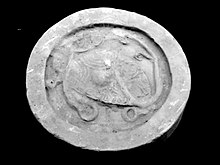Black Tortoise (Chinese constellation)
|
Black Tortoise Black Turtle |
|||||||||||||||||

The Black Tortoise depicted on a Chinese tile
|
|||||||||||||||||
| Chinese name | |||||||||||||||||
|---|---|---|---|---|---|---|---|---|---|---|---|---|---|---|---|---|---|
| Chinese | |||||||||||||||||
| Literal meaning | Dark Warrior Mysterious Warrior |
||||||||||||||||
|
|||||||||||||||||
| Vietnamese name | |||||||||||||||||
| Vietnamese alphabet | Huyền Vũ | ||||||||||||||||
| Korean name | |||||||||||||||||
| Hangul | 현무 | ||||||||||||||||
| Hanja | 玄武 | ||||||||||||||||
|
|||||||||||||||||
| Japanese name | |||||||||||||||||
| Kanji | 玄武 | ||||||||||||||||
| Hiragana | げんぶ | ||||||||||||||||
|
|||||||||||||||||
| Transcriptions | |
|---|---|
| Standard Mandarin | |
| Hanyu Pinyin | Xuánwǔ |
| Yue: Cantonese | |
| Yale Romanization | yun4 mou5 |
| Jyutping | jyun4 mou5 |
| Southern Min | |
| Hokkien POJ | gôan-bú |
| Transcriptions | |
|---|---|
| Revised Romanization | Hyeon-mu |
| Transcriptions | |
|---|---|
| Revised Hepburn | Genbu |
| Kunrei-shiki | Genbu |
| Black Warrior of the North | |||||||

A copper Black Tortoise from the Yongle era of the Ming dynasty (early 15th century)
|
|||||||
| Chinese | |||||||
|---|---|---|---|---|---|---|---|
|
|||||||
| Transcriptions | |
|---|---|
| Standard Mandarin | |
| Hanyu Pinyin | Běifāng Xuánwǔ |
The Black Tortoise or Black Turtle is one of the Four Symbols of the Chinese constellations. Despite its English name, it is usually depicted as a turtle entwined together with a snake. Further, in East Asia, it is not called after either animal but is instead known as the "Black Warrior" under various local pronunciations. It is known as Xuanwu in Chinese, Hyeonmu in Korean, Genbu in Japanese and Huyền Vũ in Vietnamese. It represents the north and the winter season.
In Japan, it is one of the four guardian spirits that protect Kyoto and it is said that it protects the city on the north. Represented by the Genbu Shrine, which is located to the north of Kyoto Imperial Palace.
The creature's name is identical to that of the important Taoist god Xuanwu, who is sometimes (as in Journey to the West) portrayed in the company of a turtle and snake.
During the Han dynasty, people often wore jade pendants that were in the shape of turtles. Because of ancient Chinese influence on Japan, honorific titles and badges in Japan also often referred to the turtle or tortoise.
The northern gates of Chinese palaces were often named after the Xuanwu. Most famously, the Incident at Xuanwu Gate, where Li Shimin killed his brothers Jiancheng and Yuanji and seized power in a coup, took place at the north gate of the Taiji Palace, in the north of Chang'an.
...
Wikipedia
